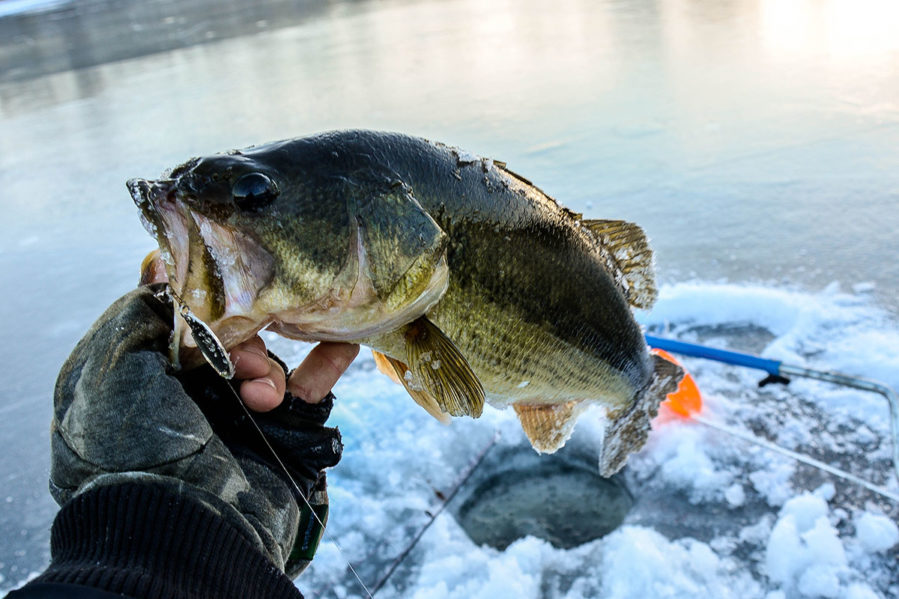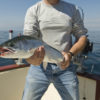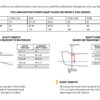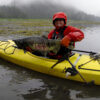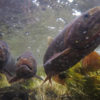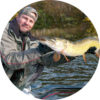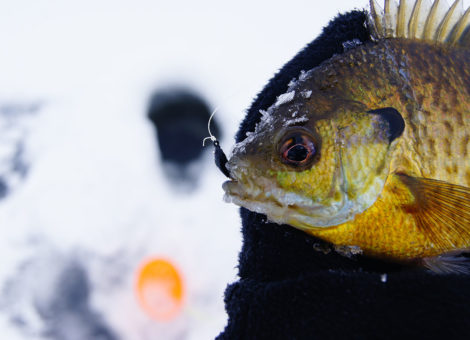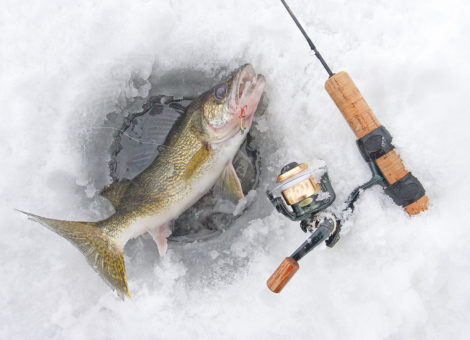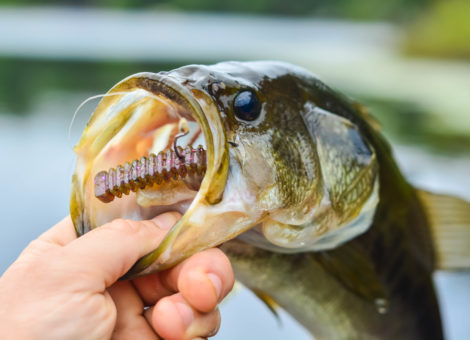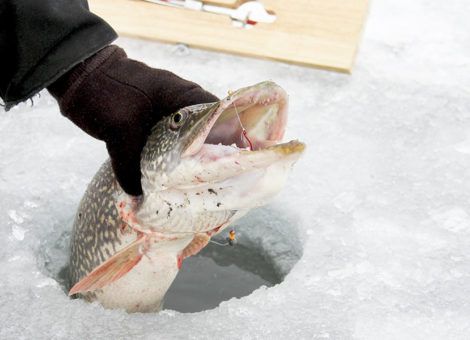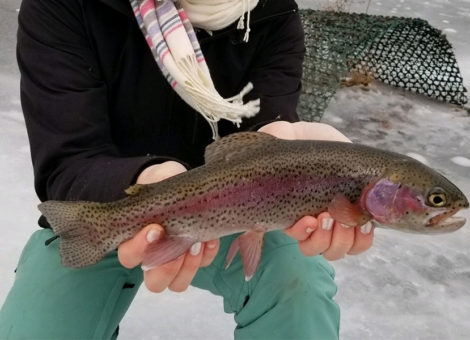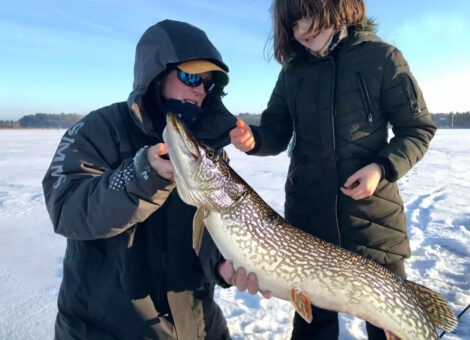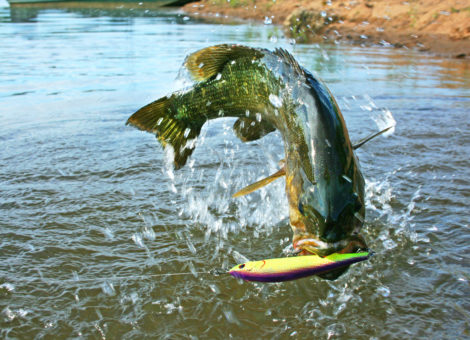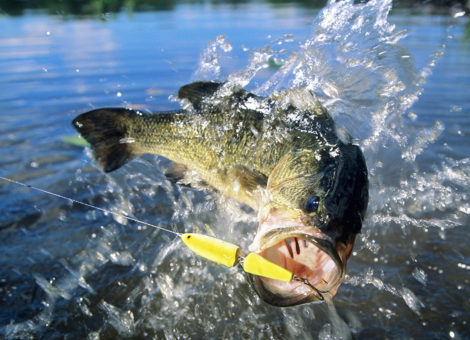Often overlooked by ice fishermen as a target species, the Largemouth bass is rarely a consideration and thus unpressured by ice fishermen in the winter. This is a shame for multiple reasons: 1. Largemouth are no slouches and put up a great fight even in cold water conditions. 2. They readily accept both natural and artificial baits, and 3. during the colder months of the year, I dare say they taste substantially better than in summer. With this guide, I hope to share some of my favorite methods to target these lovable green blobs through the ice.
The Largemouth Bass
Needing no introduction, the Largemouth is possibly the world’s most recognized fish. Billions of dollars in tackle, marketing, and tournaments have made it a prize amongst any angler, young and old. There is a common consensus that when the frosty grip of winter covers a lake that the largemouth bass goes dormant and doesn’t feed. This, fortunately, is far from the truth.
Largemouth do feed over the winter months of the year. It’s just they become docile and slow due to a decreased metabolism. Spending most of the fall fattening up, Largemouth bass will typically rely on their fat reserves to push them through the colder months when the water drops below 40℉. Not to imply that a bass will not take a larger lure or bait, but your presentation and size should be drastically downsized to account for their reduced metabolism and lethargic nature.
Largemouth Bass Habits during the Winter
During the summer, you can expect a Largemouth in shallow water to be tucked under a grass mat, looking up at the water’s surface for any small fish or amphibians to swim by. In the winter, they are doing the total opposite. You can find them slowly gliding along the bottom with their noses pointed down, only using their pectoral fins to navigate. In winter, they are focused on sipping up small insects, minnows, and bugs that are less energy-intensive to forage for.
The habits of Largemouth Bass tend to very from lake to lake. In some lakes, the Largemouth are more solitary and prefer to forage in smaller groups; in other lakes, they stack like dominoes on top of one another. Local knowledge will help determine how and where the bass will hold up under the ice in a particular lake.
Where to Ice fish for Largemouth Bass
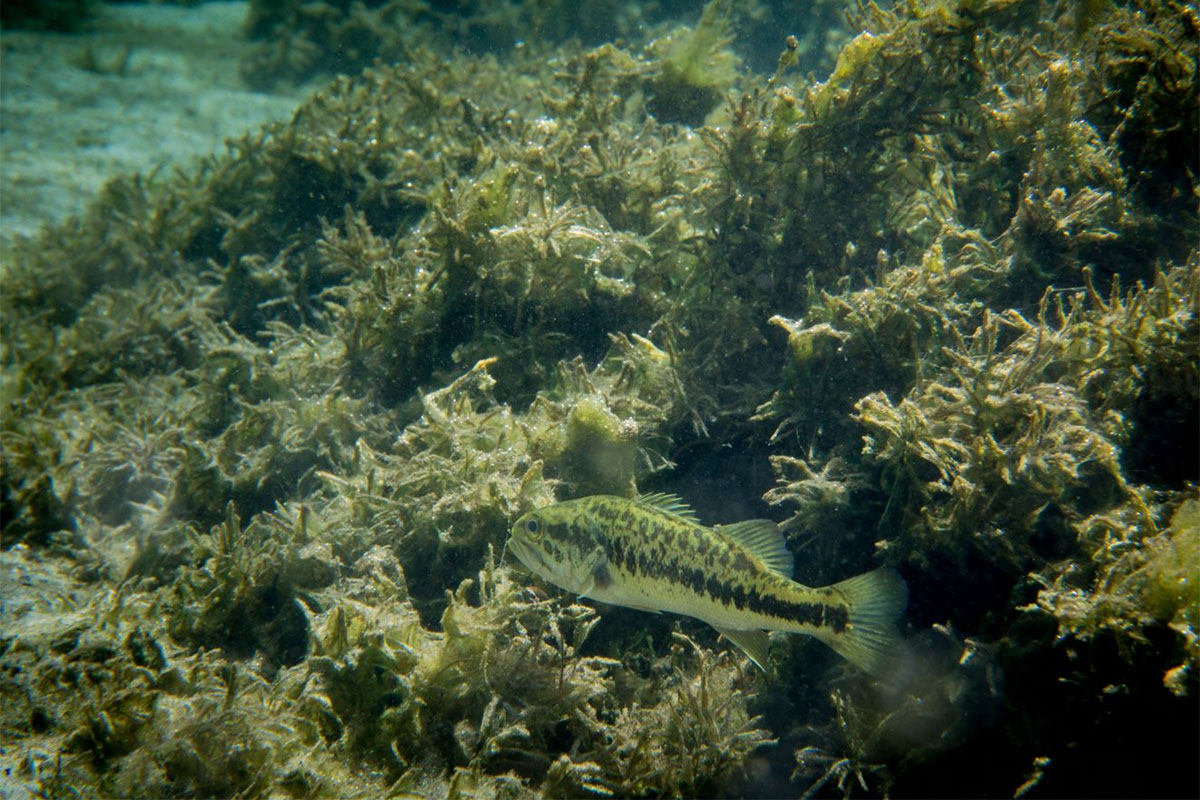
Any Green Vegetation – If you can locate green vegetation in a frozen lake, typically, you can find largemouth bass, crappie, and other pan fish. Look for protected areas off the sides of points or just inside cuts in coves off the main lake. These deeper, calmer holes are not subject to drastic fluctuations in water temperature and can maintain healthy underwater vegetation that Largemouth and their prey love to hide amongst. Try to fish the outside edges of the foliage closer to drop-offs where Largemouth can forage and ambush unsuspecting prey.
Structure – if the lake you are fishing on has no vegetation visible and is essentially a giant bowl, look for deeper structures in the lake where Largemouth bass will tend to congregate. This structure can include log piles, boulders, and artificial structures. Typically, these areas will hold a decent amount of plant material for insects, minnows, and other baitfish to feed on, and thus for the Largemouth to feed upon them.
Depth – Like many other species, Largemouth typically will not hold in shallow water when there is ice on the lake’s surface. They prefer deeper areas that don’t fluctuate in temperature throughout the day. My point is the smaller tributaries or flats that are highly productive in the spring and fall will likely not hold any fish during the winter months. Some exceptions exist, especially if you can find areas with lush green vegetation below the ice, but that might be an unlikely scenario. Most of your Largemouth will be caught between 10-20ft on most lakes during the winter months.
Best time to get a bite
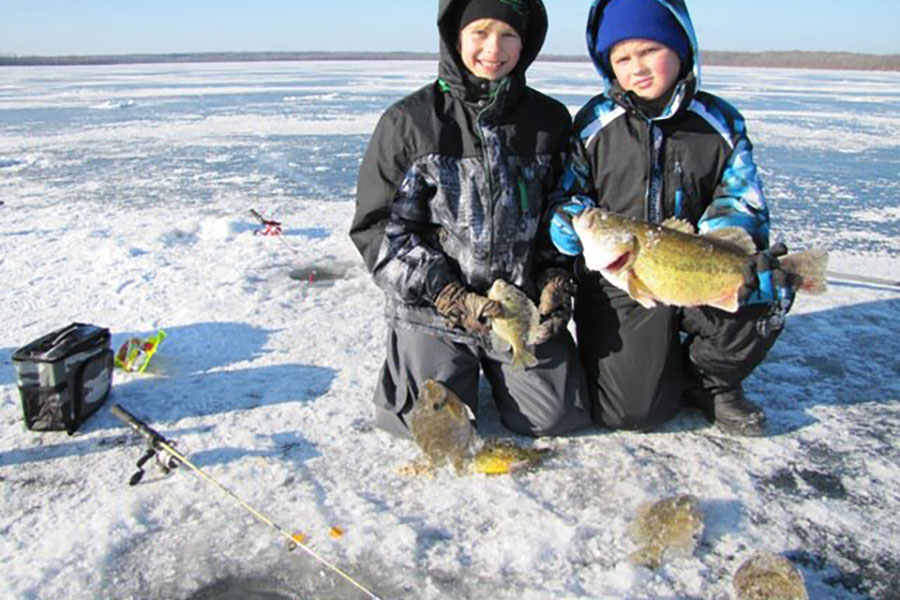
Tackle and Gear suggestions
Reel – A 3000-size reel is as big as you want when targeting Largemouth through the ice. You can use smaller reels; however, areas frequented by big Largemouth through the ice are also patrolled by Walleye, Pike, and Musky.
Rod – For Largemouth, I use a range of rod sizes between 24-30inches in length. Because they become relatively docile in the winter, even smaller rods can handle large fish greater than 4-5lbs.
Line – Depending on how pressured the fish are in your lake or how clear the water is will dictate the line class you should use. For me, on more transparent lakes, I’ll use 2-4lb fluorocarbon; on muddier lakes, I’ll go up to 8lb test if the fish are biting. Also, remember that line size changes the presentation of lures and baits, where a lighter line provides a more natural look.
Other Equipment
Cordless Ice Augurs – Whether it’s gasoline or electric, this item alone is worth its weight in gold when scouting a lake and having to bore multiple holes.
Long needle-nose pliers with wide grips – Arguably, the most annoying part of ice fishing is having to remove your gloves. A nice pair of pliers will limit these skin to atmosphere interactions.
Water repellent or water-proof gloves – Need I mention why?
Best Baits and Lures
As mentioned before, Largemouth bass can become lethargic during the year’s colder months. They still will eat anything they can fit into their mouths, but they are typically feeding on much smaller prey items during this time. Due to this behavior, it’s generally recommended that you downsize your fishing equipment from the 12in worms you use during the humid summer nights in July to smaller baits.
Live bait – Of course, if you have the gumption, you can haul around a bucket of minnows to each of your spots on the frozen lake and probe for Largemouth. But it’s much more effective to search with artificial lures first and then break out the live bait once you know they are holding in a spot. Remember, Largemouth don’t move much during the winter, so it’s likely if they were there yesterday, they will be there today. All the usual suspects for live bait will work for Largemouth during the winter; night-crawlers, wax worms, and minnows are my typical go-to live baits. If you use minnows or shiners, use a smaller class of minnow usually reserved for crappie fishing.
A suitable method when using live bait is to hook small crappie minnows through the lips utilizing a micro-jighead as light as 1/64 oz. This method provides a natural and light presentation that is unlikely to scare away more finicky fish.
Artificial bait – When it comes to artificial bait for Largemouth bass, keep it simple and small. Jig-heads as small as 1/64 oz are remarkable for their natural-looking fall through the water column. If fishing in deeper water, you can move up to 1/32oz or even 1/16th if the bite is on. Minnow or grub patterns work great, especially with a small amount of flash on sunny days when the light is penetrating through the ice. On darker days, it’s appropriate to put on some glow-in-the-dark paint or spray for added visibility.
General technique when using artificial baits are small, slow upward pulls around 10inches, and then letting the bait naturally drop back down to the bottom. Don’t let your lure rest on the bottom. Instead, try keeping it a foot or a few inches above it. Remember, you want your bait to be the smallest, easiest-looking prey item for the bass to eat.
Using Tip-ups when ice-fishing for Largemouth Bass
If you are like me and enjoy auguring a ton of holes in the ice, making sure each of those holes are manned by a lure or bait can be beneficial to catch more fish. Tip-ups offer a fantastic solution to this problem by setting the hook for you and indicating that you have a fish. At the same time!! Just select the bait, load the spring-loaded flag, and walk away. The flag will trigger when a fish bites the line, automatically alerting you to a bite and setting the hook on the fish.
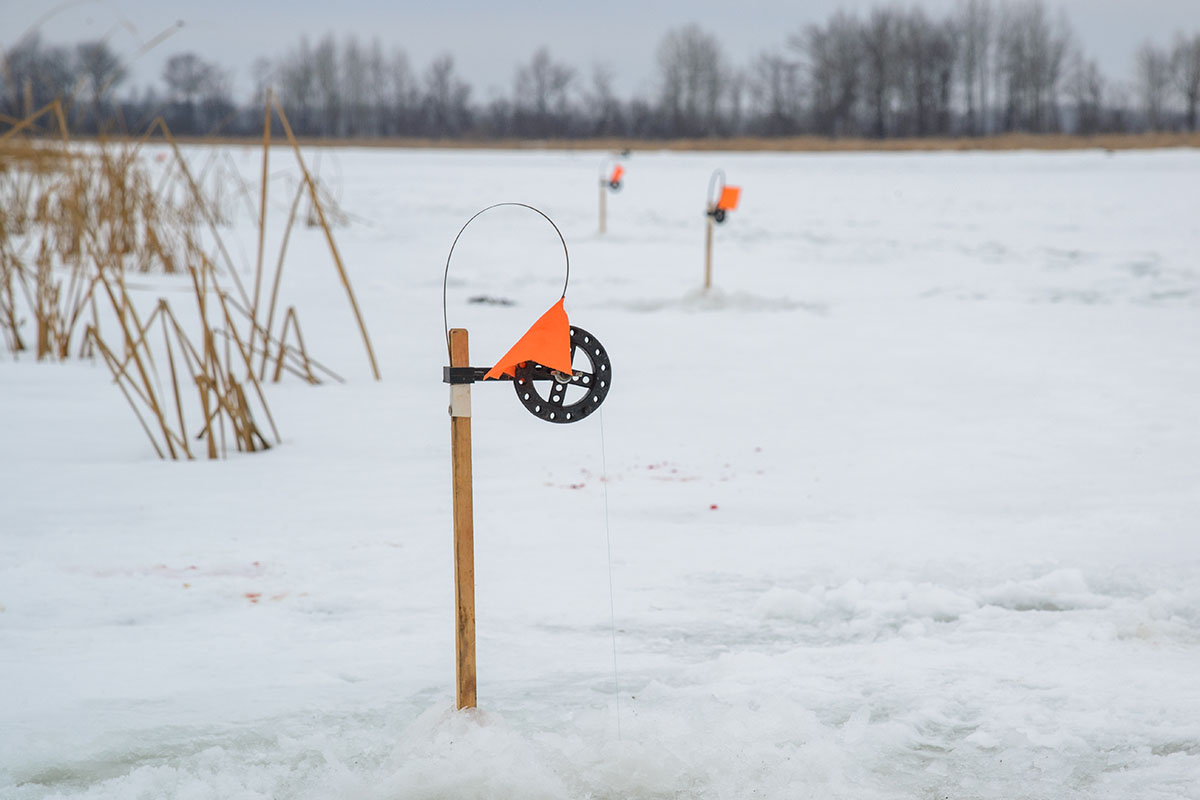
Tips From the Pros for Catching Largemouth Bass through the ice
- Scout Underwater Structure before the Freeze – One of the best methods to find Largemouth over the winter is to find log piles, structures, and vegetation in the fall before the lakes freeze over. Catching Largemouth bass in the winter typically isn’t a matter of what bait you use. It’s a more matter of where you are using the bait. If you are a suave, smooth talker, you might get one of the locals to divulge their secret spots at the bar in the evening after a couple of drinks if you forget this tip.
- Use a GPS device – If you’re unfamiliar with the lay of the land (in this case lake) a good GPS mapping and charting system can help you find structure, points and flats where Largemouth bass are likely holding up. You’ll save a lot of time and eliminate a lot of unproductive water to target likely spots using contour maps generated via GPS.
- Connect Augured Holes – Requiring more work, I like to widen the holes I’m fishing by auguring multiple holes next to each other and using an ice-pick or spade to connect them. This method provides a larger landing platform for larger fish and lets me put a little horizontal movement on my baits and lures. Caution: Using larger holes will reduce ice structural integrity, so ensure you have a thick surface to work with.
- Tip Your Artificial Lures with live or dead bait – Some argue that using any natural bait on the end of an artificial hook doesn’t count. I typically don’t hear these statements over the sound of me catching more fish than them. When ice-fishing, you want to use every trick at your disposal to attract more fish and get those fish to bite your hook. If throwing a little bit of a waxworm on my spoon’s hook gets the bite. I’ll use it every time.
- Don’t stick with one hole too long – As soon as ice starts to form on the lake vegetation starts to die off and bass begin moving about looking for new patches of vegetation or structure where they can find food. Finding where bass are can be tricky at times. Create a series of holes in the ice strategically positioned near structure and contours where Largemouths are likely to be holding up. Fish each hole for about 10 to 15 minutes. If you dont get a bit, move on to the next hole.


